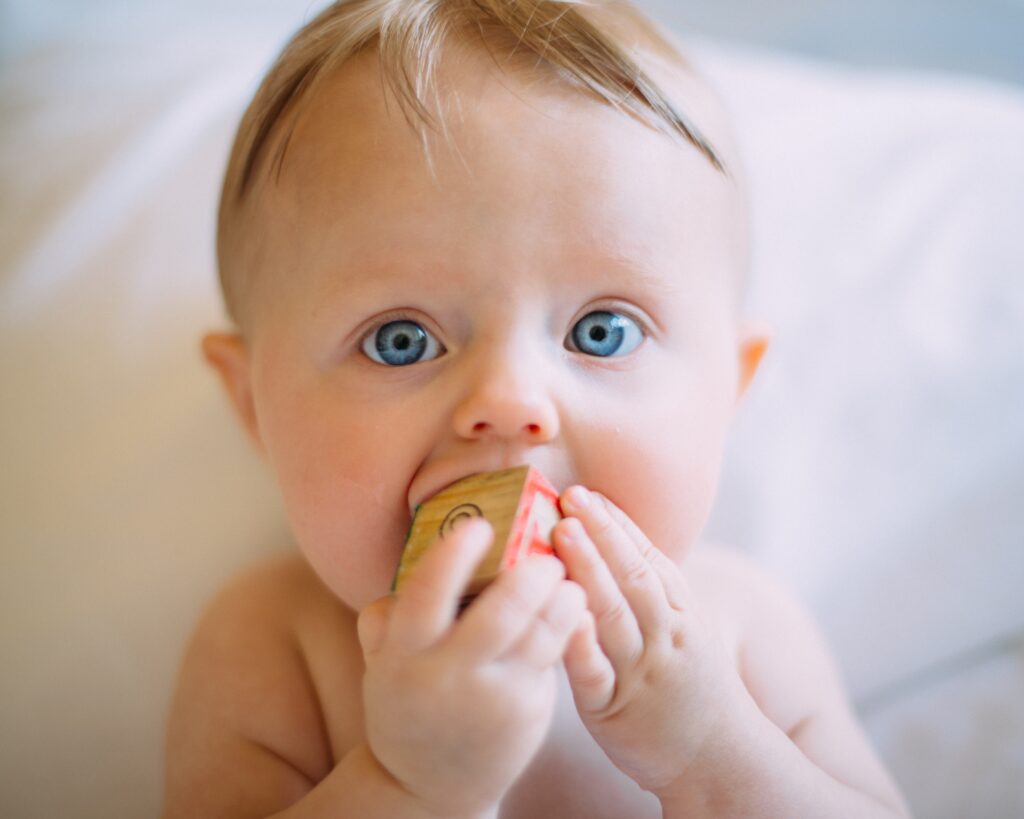Introducing a Pacifier

Pacifiers are a topic that sparks many debates among parents and caregivers. Some swear by them as a soothing tool for fussy babies, while others express concerns about their potential drawbacks. At Bay City Doulas, we believe in providing balanced information so you can make informed choices for your little one. In this comprehensive guide, we’ll delve deeper into the world of pacifiers, types, benefits, potential drawbacks, and when to introduce them to your infant.
What is a Pacifier
A pacifier, informally known as a “binky” or “soother,” is a small, nipple-shaped device designed for babies to suck on. Typically, a pacifier comprises three key components: the nipple, the shield, and a handle or ring for easy handling.
The nipple, which babies suck on, comes in various shapes, such as orthodontic and cherry-shaped, and manufacturers usually craft it from silicone or latex. The shield, which prevents the baby from swallowing or choking on the nipple, is generally made of plastic or rubber. The handle or ring offers a convenient way for parents and caregivers to insert or remove the pacifier.
The invention of the pacifier
Pacifiers have ancient roots dating back centuries, and various factors have shaped their evolution. Understanding their historical context reveals why pacifiers were initially conceived and how they have evolved over time.
- Ancient Roots: Pacifiers have ancient origins, with evidence of their use dating as far back as the Roman Empire. “People often crafted pacifiers from materials like figs or dates, using them to soothe infants and provide them with something to suck on.”
- Medical Advancements: In the 17th and 18th centuries, pacifiers made of porcelain or coral gained popularity among European aristocrats. These early versions were believed to encourage dental development and were considered status symbols.
- Modern Progress: The 20th century witnessed significant pacifier design and material advancements. Rubber and later silicone became prevalent materials for the nipple, and pacifiers were mass-produced for widespread use.
The Purpose of Pacifiers
Pacifiers were invented and have evolved for several reasons:
- Soothing: The primary purpose of a pacifier is to soothe and comfort babies. Sucking on a pacifier provides a rhythmic, non-nutritive form of self-soothing that can help calm a fussy or upset infant.
- Oral Stimulation: Pacifiers offer oral stimulation, which can be pleasurable and satisfying for infants. This oral activity can also help in the development of oral motor skills.

Benefits of Pacifiers
- Soothing: Pacifiers can provide comfort and help calm a fussy or colicky baby, offering a brief respite for the infant and the caregiver.
- Reduced Sudden Infant Death Syndrome (SIDS) Risk: Some studies suggest that pacifier use during sleep may reduce the risk of SIDS. However, following safe sleep guidelines and consulting with your healthcare provider is essential.
- Oral Development: Orthodontic pacifiers may promote proper oral development by encouraging babies to suck in a way that is similar to breastfeeding.
- Temporary Distraction: Pacifiers can serve as a temporary distraction during moments of distress or discomfort, such as vaccinations or teething.
- Weaning Aid: Pacifiers can be helpful during the weaning process, providing comfort to infants transitioning from breast or bottle feeding.
How Pacifiers Calm Babies
One of the remarkable aspects of pacifiers is their ability to tap into a natural reflex that babies are born with—the sucking reflex. Babies have a strong urge to suck, which serves various purposes:
- Self-Soothing: Sucking is a natural way for babies to self-soothe and find comfort. The rhythmic motion of sucking can be calming, helping to pacify a fussy or upset infant.
- Nutrition: For breastfeeding babies, sucking is essential for obtaining nourishment from the breast. However, babies may continue to suck for comfort even after a feeding session.
- Oral Stimulation: Sucking also provides oral stimulation, which can be pleasurable and satisfying for infants.
Potential Drawbacks
While pacifiers have their advantages, it’s essential to be aware of the potential drawbacks and exercise caution:
- Nipple Confusion: Introducing a pacifier too early, especially within the first few weeks of life, may lead to nipple confusion for breastfeeding infants. This can make it challenging for them to latch onto the breast correctly.
- Dental Issues: Extended pacifier use or reliance on non-orthodontic pacifiers can potentially lead to dental problems, such as overbites or misalignment of teeth. It’s advisable to limit pacifier use as your child gets older.
- Dependency: Some babies may become dependent on pacifiers for soothing, which can be challenging to break later on. Consider weaning strategies if you decide to introduce a pacifier.
When to Introduce a Pacifier
The timing of introducing a pacifier can play a crucial role in ensuring it doesn’t interfere with breastfeeding and oral development. “The American Academy of Pediatrics (AAP) recommends waiting until breastfeeding is well-established, typically around three to four weeks of age, before introducing a pacifier.”This minimizes the risk of nipple confusion while allowing the infant to establish a good breastfeeding routine.
However, it’s important to note that many parents choose to introduce a pacifier from day one. While this may work well for some infants, it’s important to monitor how it affects breastfeeding and ensure that your baby is latching and nursing effectively.
Pacifier Safety Guidelines
In addition to considering when to introduce a pacifier, it’s essential to follow safety guidelines to ensure your baby’s well-being:
- Choose the Right Size: Select a pacifier appropriate for your baby’s age and development.
- Keep It Clean: Regularly clean and sterilize pacifiers to prevent the buildup of harmful bacteria.
- Inspect for Wear: Check pacifiers for signs of wear and tear and replace them as needed to avoid choking hazards.
- Limit Use: Use pacifiers as a soothing tool, but avoid prolonged or constant use, especially as your child ages.
- Safe Sleep: If your baby uses a pacifier during sleep, ensure it’s age-appropriate and follow safe sleep guidelines, placing your baby on their back to sleep.
There are so many things to debate and consider as new parents. Pacifier use is one of them! At Bay City Doulas, we are not here to tell families what to do. Our hope is to help educate parents so they can make the best decision for themselves. If you have further questions, we are here to help.
Thank you for reading this weeks’ blog, ” Introducing a Pacifier.” For more tips and tricks on all things pregnancy, parenthood, and postpartum, click here!

